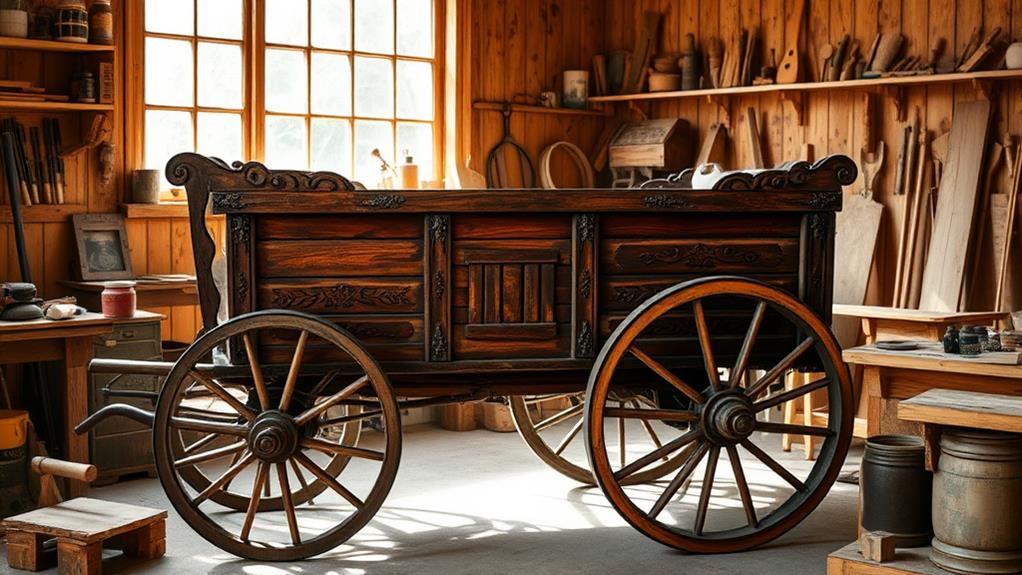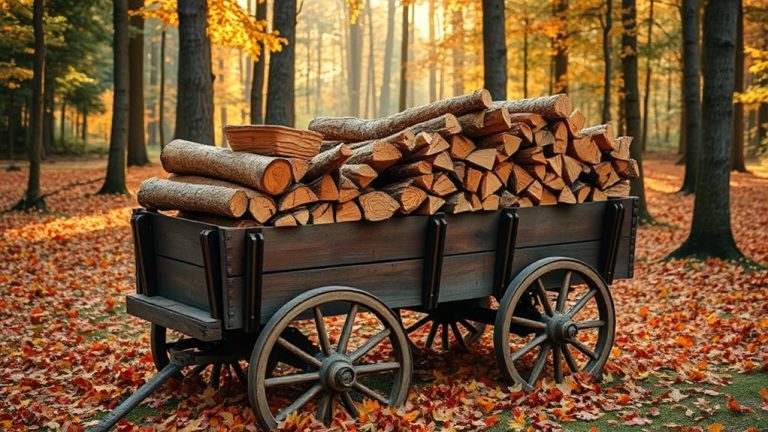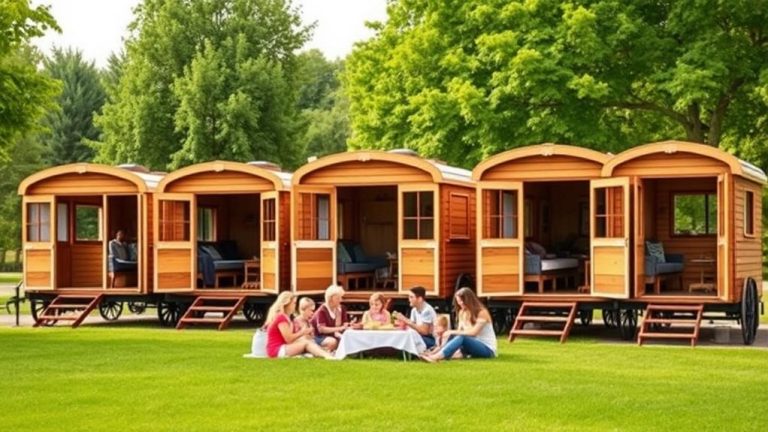To revive antique wooden wagons, start by inspecting the structure carefully. Check the wooden frame for wear, and verify joints and connections are intact. Next, clean the wood using a soft brush and a gentle soap solution, then sand rough patches with fine-grit sandpaper. Finally, apply a suitable finish, like an oil-based varnish for durability or a water-based option for a quicker application. Don’t forget to seal the surface to protect against moisture and UV damage. If you’re curious about more techniques and tips, there’s much more to explore in this fascinating restoration process. For an authentic look, consider using historically accurate paints or stains that match the wagon’s original design. Regular maintenance, such as reapplying protective finishes and checking for signs of wear, will help preserve its charm for years to come. If you’re looking for more wooden wagon restoration tips, researching traditional craftsmanship techniques can provide valuable insights into restoring these timeless pieces.
Inspecting the Wagon Structure
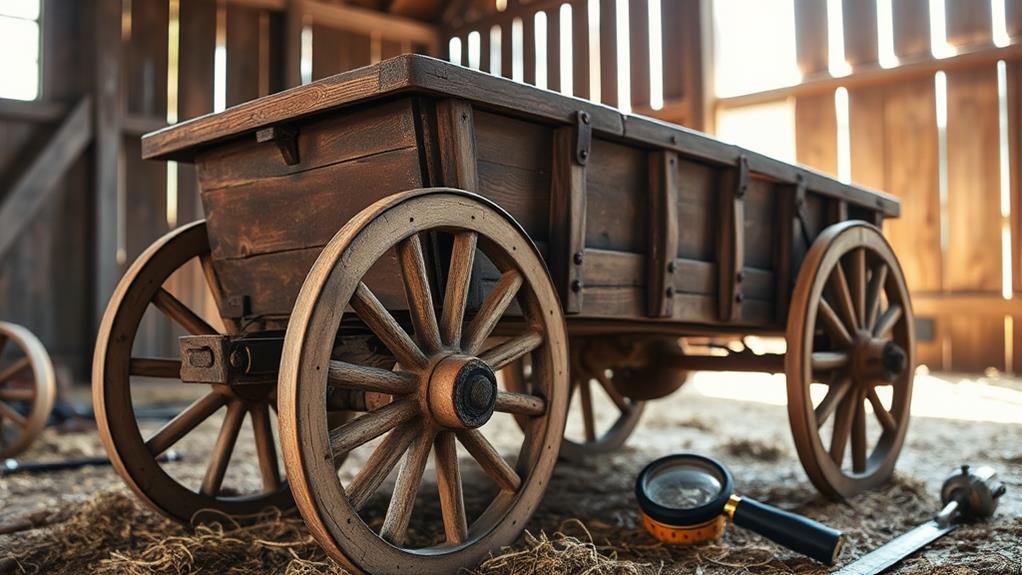
When you're inspecting the wagon structure, it's vital to start with a thorough examination of the wooden frame for any signs of wear or damage. Look closely at joints and connections, as these areas often bear the brunt of stress and may show cracks or separation. Identifying damage early can save you time and effort later on.
Next, assess the stability of the entire structure. Gently shake the wagon to see if it wobbles; any instability could indicate weakened beams or rotting wood. Pay special attention to the wheel mounts and axles, as these components are critical for maintaining balance and functionality.
Don't forget to check for insect infestations, particularly from termites or wood-boring beetles. Such pests can compromise the integrity of the wood, leading to further instability.
Cleaning and Restoring the Wood
After confirming the wagon's structure is sound and free from any significant damage, the next step involves cleaning and restoring the wood to bring back its original luster. Different wood types, like oak or maple, require specific care, so knowing what you're working with is essential. Here's a methodical approach to cleaning and restoring the wood:
- Dust and Debris Removal: Start by using a soft brush or cloth to remove any loose dirt or debris from the surface.
- Cleaning Solution: Mix a gentle soap solution with warm water. Dip a cloth in it, wring it out, and gently wipe the wood, being careful not to soak it.
- Drying: After cleaning, dry the wood thoroughly with a clean, dry cloth. Make sure no moisture remains, as this can cause damage.
- Sanding: For deeper restoration, use proper restoration tools like fine-grit sandpaper to smooth out any rough patches. Always sand with the grain to avoid scratches.
Finishing Touches and Preservation
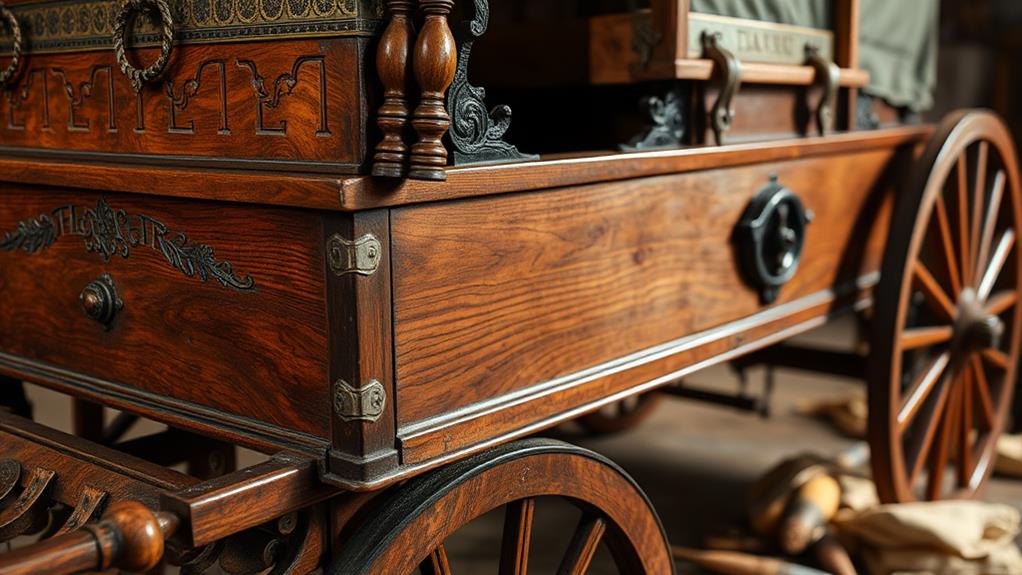
Once you've restored the wood to its former glory, it's vital to apply the finishing touches that will protect your antique wooden wagon for years to come. Start by choosing finishes that suit the wagon's character and intended use. For a classic look, consider oil-based varnishes that improve the wood's natural grain as well as providing a durable surface. If you prefer a more modern approach, water-based finishes are less toxic and dry quickly, making them a practical choice.
Next, focus on applying sealants to safeguard against moisture and UV damage. A high-quality sealant will create a barrier that prevents warping and cracking, preserving the integrity of your wagon. When applying sealants, verify the surface is clean and dry. Use a brush or a spray application for an even coat, and allow each layer to cure fully before adding more.
Frequently Asked Questions
How Do I Determine the Age of My Antique Wooden Wagon?
To determine the age of your antique wooden wagon, start by researching its wagon history. Look for specific features like the design, materials, and construction methods used. You can additionally check for maker's marks or stamps, which often indicate the manufacturer and date. Restoration techniques may reveal further clues, as methods vary by era. Consulting vintage catalogs or experts in antique vehicles could provide valuable insights into your wagon's age and significance.
Can I Use Modern Tools for Restoration Without Damaging the Wood?
When considering modern restoration, it's essential to select tools that won't harm the wood. You wouldn't want to use a forceful sander like a bulldozer in a flowerbed! Instead, opt for gentle hand tools, like fine chisels and soft-bristle brushes, to preserve the wood's integrity. Always test any modern product on a small area first. Remember, your goal is to improve, not overpower, the antique beauty of your wooden wagon.
Where Can I Find Replacement Parts for My Antique Wagon?
When searching for replacement parts for your antique wagon, start by exploring antique parts suppliers that specialize in vintage wagon restoration. Websites like eBay or Etsy often feature sellers with authentic parts. Furthermore, local restoration shops or flea markets might stock what you need. Don't forget to connect with online forums or communities; fellow enthusiasts can provide valuable leads and tips on sourcing those hard-to-find components crucial for your wagon's revival.
What's the Best Way to Store the Restored Wagon?
To store your restored wagon, make certain it's in a proper environment—cool, dry, and away from direct sunlight. This helps prevent warping and damage. Use a protective covering, like a breathable fabric tarp, to shield it from dust and moisture during air circulation. Avoid plastic covers, as they can trap humidity. Regularly check on it to maintain its condition, making sure your wagon remains a cherished piece of your collection for years to come.
Are There Any Safety Concerns When Working on Antique Wagons?
When you're restoring antique wagons, think of a craftsman wielding tools with purpose. Tool safety's essential—always wear protective gear and handle equipment carefully. You don't want to risk injury as you bring history back to life. Furthermore, be cautious of chemical exposure; many restoration products contain harmful substances. Ventilate your workspace well, and consider using eco-friendly alternatives. By prioritizing safety, you can enjoy the freedom of creating without unnecessary risks.

